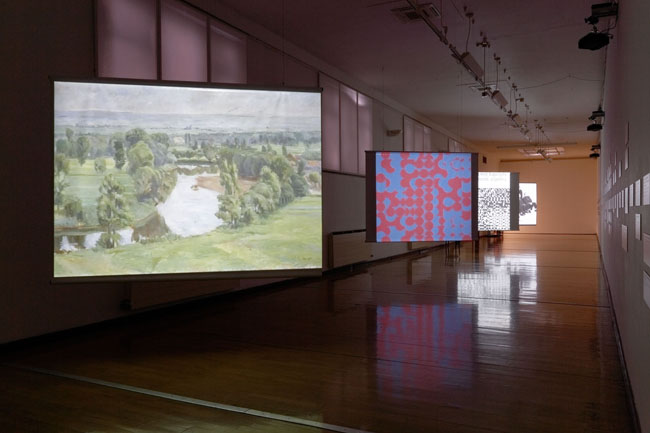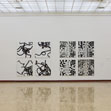texts about zs
It would be prudent to erase the contrast lines between subjective and objective creation because both processes occur in parallel and cannot be separated. Even though I use systems in my work it is paradoxical that they are the result of my intuition.
ZS, 2006
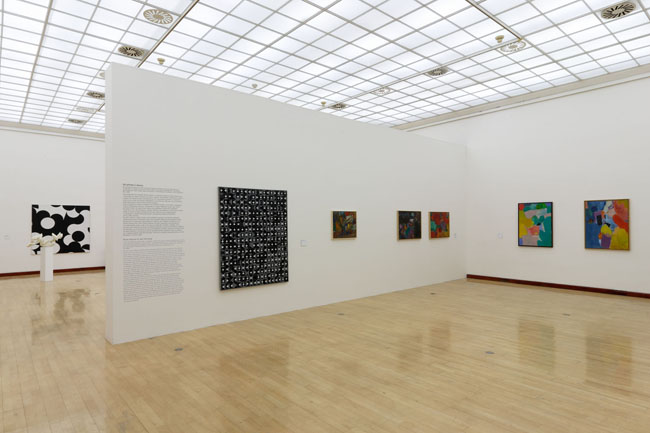
The approach of primarily intuitive decisions about the painting was abandoned by Sýkora at the start of the 1960s, to be replaced by the first rationally conditioned system of geometric paintings. This closed system, in which the composition was still decided by its author, soon found itself replaced by the first open system, where it was enough simply to make an indication and continue with it infinitely. The combinatory principle, on which the Structures were founded, replaced traditions of intuitive composition, painterly experience and visual convention. And he continued to work with the open system, in his line-paintings, only with the elimination of several limits and the replacement of programming with randomness.
Were we to select several paintings from the individual stages of Sýkora´s career over the past half-century, from the Gardens to the Lines, and view them through the eyes of the general public not aware from of what specific system underlies them (or whether they were in fact painted without one), we would most likely, in many cases, be unable to tell apart the programmed works from those based on chance, or the rationally grounded ones from the ones intuitively composed. Nor would we even do much better at arranging them in chronological order. Indeed, even today many art historians regard the structure-paintings as the work of chance and the line-paintings as computer creations, or the “blotches” from the 1990s as his early abstract work. Yet nonetheless Sýkora´s paintings are greatly admired by the lay public.
Sýkora himself never regarded the concrete systems as essential: what interested him was the result, the autonomous work. It was essentially the same basic theme that for his entire life helped him in capturing his sense of reality. And it was also the same obsession that gave him the strength again and again to refine and perfect his own system, to spend several months on the demanding realisation of a single canvas that, in many respects, he could easily have printed on a large-format press. Yet in spite of it all (and in spite of all of the rest) he has always remained a painter. In his artwork there is no calculation: it is a lifelong quest for something, and never against anything; the immediate and joyful devotion to his chosen task.
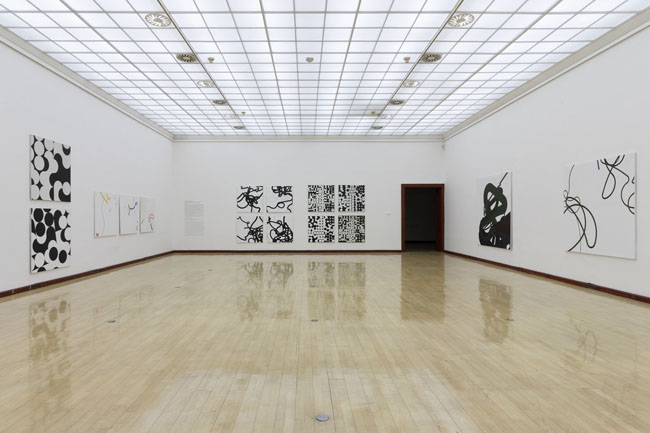
The amazing compactness of his entire œuvre is the fortunate result of such a continual approach. Each painting directly draws upon the new experience from the previous realisation, each new work indicates further possibilities yet at the same time bears within itself part of the heritage of its predecessors. Experience from the “Gardens” period was put to use both for the definition of rules for structure paintings as well as for the choice of the “themes” of the line-paintings. And behind the coherence of this painted corpus are the highly general questions posed at the very outset of Sýkora´s conscious painterly self-development.
Sýkora´s rational system is used intuitively, while the result of employing a rational method is invariably a distinct emotion – the painting that is nothing more than itself – precisely despite (or because of) the presence of an echo of the artist´s existential sensations; the ungraspability of the world, the uncertainty of what human existence means, the infinite. (see note 1) The more I wish my paintings to be merely what they are, the more they are everything.” (see note 2)
Precisely the conception of the system as the outcome of painterly intuition is the key for Sýkora – he never uses systems mechanically, never to illustrate theoretical problems, invariably he strives to fulfil his own sense of the painting, the shift towards a definite desired emotion. He strains to achieve a specific artistic expression, which either shifts his “investigation” of artistic morphology or brings its closer to a specific feeling. Through the use of systems, he endeavours to bring into accordance what he experiences, what he feels, with what he paints. A sense of reality, of the artist´s entire life is reflected in his paintings, however much they are, on the basis of his own decision to a clear extent independent.
Also fitting within the context of the late “Gardens”, the Structures and the Lines are Sýkora´s intuitively composed paintings from left-over bits of paint, formed during the 1980s and 1990s in his studio during his work on line-paintings, which he has formally termed “Spots” or less formally as “Blotches”. It is proof of his consistent dialectical approach to artistic creation, in which the rational and the emotional forever interweave, without differentiation. These paintings are not simply a form of relaxation: they are the continuation of the intuitive aspect of his work. If in the mid-1960s Sýkora had returned to his free-form landscapes, working on them in tandem with his Structures (And even later with his Lines), formally re-visiting the period before the Gardens, the Spots tend more to echo the later phase of the Gardens. Several are only lightly cast down onto the canvas, while others bear the traces of repeated re-painting, as in the later Gardens. Even in these cases, both brushes and paint-trowels are used for adjusting colouristic relations. The painting Skvrny [Spots], 1992, 100 x 100 cm was left in the studio for many years, and changed its visual form completely several times before it finally satisfied the painter´s sense of a balanced composition. During this period, he even turned the picture onto its side repeatedly, deciding on its definitive orientation only shortly before signing it. Another painting created in the same method took up to nine years to complete. Several of the stains (not unlike the compositions from the 1960s), weigh several kilograms; often, their final surface masks a number of equally satisfying compositions (confirmed by photographs from the studio), or in certain situations an entire landscape-motif, painted directly from nature, vanished beneath their surface. And there are also paintings with which the artist was not finished even after their set completion, paintings that he altered directly before the gaze of their new owners. This aspect is proof of Sýkora´s spontaneous and passionate approach to painting, which he retained for all of his life. In painting, he never regarded anything as fully complete: to paint was an endlessly occurring process, in which we can only take our part and capture the fleeting records of the autonomous events running along outside of our control or understanding. Confirming this intriguing direct link between the spots and the artist´s overall trajectory are several parallel attempts at solving the problem of surfaces using a system of Lines. In one of the notebooks are several sketches of a possible solution form the early 1990s. However, Sýkora finally decided not to continue in the path indicated by it, giving priority to a simpler method. The results include, for instance, paintings Lines No. 124 or Lines No. 130, where he achieved the enclosure of colour surfaces by allowing the edges of the line to move around the surface not in parallel but along their own paths, following different sequences of random numbers.
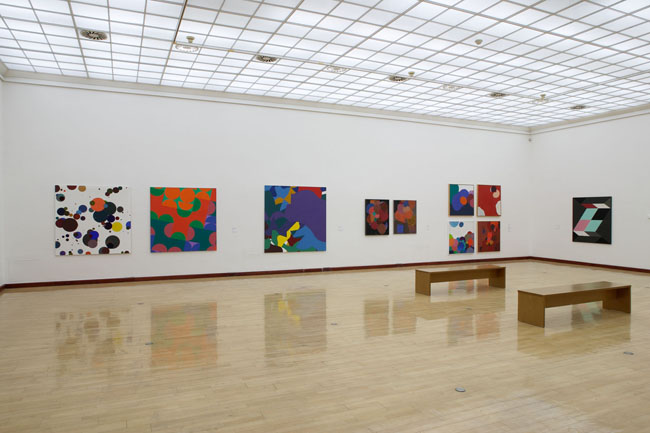
Interest in similar artistic problems can be found even earlier, in the polychromatic Structures and particularly in the enlarged details of macro-structures, Barevná makrostruktura [Coloured Macrostructure], 1972, 150 x 150 cm. In another sense, the spots also resemble the extreme version of application of the linear system – null lines formed by circles of paint, a figure to which Sýkora repeatedly returned, e. g. Lines No. 48, 1987, 150 x 150 cm, or the paintings of thick lines, e. g. Lines No.210, 2003, 130 x 130 cm.
The spots can be regarded as an important supplement to Sýkora´s rational approach, possibly even as the very essence of his stance as a painter. These are paintings for the joy of it (even though nothing even here is made easy), alongside the often demanding fulfilment of the artist´s own complex self-assignments in completing the line-paintings. All of his artworks are derived from a single spirit, both aspects of his work reach the same conclusion through differing means. Indeed, the relation of the rational and the emotional is something that Sýkora regards as a natural feature of the human psyche: in artwork, both components are always represented, only in differing mutual proportions (see note 3). In his work as well, their relative proportions vary, yet it is hard to tell one from the other.
Let us try to relieve ourselves of the burden of our own thinking, which occasionally prevents us from seeing. In Sýkora´s paintings themselves, there is nothing complex, nothing coded; they are in equal measure spontaneous and planned. They are immediately accessible to everyone who stands before the canvases without prejudice, like music. For their reception, we need no guidelines or key. The path towards their significance does not require the breaking of any secret code, they never mean anything more than what they are themselves. Sýkora does not construct the content, but the form. The content is the quality of each viewer, as much as the path to a higher order does not lead exclusively through the efforts to understand but equally through an approach along the intuitive, emotional level. In his own words, Zdeněk Sýkora views the entire matter quite simply: “I have the sense that I am always doing the same thing, expressing one idea – my amazement at nature, my joy in life.” (see note 4)
1 Vítek Čapek, An Interview with Zdeněk Sýkora, 1986, in Zdeněk Sýkora. Interviews. Gallery, Prague 2009, p. 92
2 Cited in: Hans-Peter Riese, Představa obrazu a system –význam systému a systematičnost v díle Zdeňka Sýkora [The Idea of the Painting and the System – the Importance of the System and the Systematic in the Œuvre of Z. S.], in Zdeněk Sýkora. Retrospektiva [Retrospective] 1945-95. City Gallery Prague, Prague 1995, p. 26.
3 Vítek Čapek, An Interview with Zdeněk Sýkora, 1986, in Zdeněk Sýkora. Interviews, Gallery, Prague 2009, p. 78
4 Transcript of filmed material for the television documentary Zdeněk Sýkora, from the series Evropané [Europeans], Czech Television, 2001. LZS Archive
